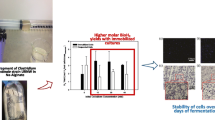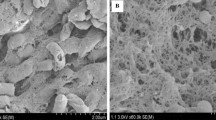Summary
The degradation of 4-chlorophenol by free and by Ca-alginate-immobilized cells ofAlcaligenes sp. A 7-2 has been studied. Increasing concentrations of 4-chlorophenol (0.4–0.55 mM) were better tolerated and more quickly degraded by the immobilized organisms than by free cells. The capability for haloarene-degradation is inducible. In semicontinuous fermentation at pH 7 a minimal degradation time of 5 h for degrading 0.2 mM 4-chlorophenol was reached. Fermentation temperature was shown to be important for inducing the degradation capability, but to be less important for the degradation rate by induced organisms. High-frequency feeding of small amounts of 4-chlorophenol (0.05 mM) was more favourable than low-frequency feeding of larger amounts (0.15 mM).
Continuous fermentation with unbuffered medium allowed a degradation rate of about 2 mmol·l-1·d-1; with buffered medium a higher degradation rate of nearly 4 mmol·l-1·d-1 was reached, but the Ca-alginate beads dissolved.
Similar content being viewed by others
References
Bettmann H, Rehm HJ (1984) Degradation of phenol by polymer entrapped microorganisms. Appl Microbiol Biotechnol 20:285–290
Dorn E, Knackmuss HJ (1978a) Chemical structure and biodegradability of halogenated aromatic compounds. Two catechol 1,2-dioxygenases from a 3-chlorobenzoate-grown Pseudomonad. Biochemical Journal 174:73–84
Dorn E, Knackmuss HJ (1978b) Chemical structure and biodegradability of halogenated aromatic compounds. Substituent effects on 1,2-dioxygenation of catechol. Biochemical Journal 174:85–94
Ehrhardt H, Rehm HJ (1985) Phenol degradation by microorganisms adsorbed on activated carbon. Appl Microbiol Biotechnol 21:32–36
Klages U, Lingens F (1979) Degradation of 4-chlorobenzoic acid by a Nocardia species. FEMS Microbiology Letters 6:201–203
Klein J (1982) Die ionotrope Gelbildung als universelle Methode zur Immobilisierung von ganzen Zellen. BMFT-Statusseminar Jülich
Knackmuss HJ (1979) Halogenierte und sulfonierte Aromaten-Eine Herausforderung für Aromaten abbauende Bakterien. Forum Mikrobiologie 6:311–317
Knackmuss HJ, Hellwig M (1978) Utilization and Cooxidation of chlorinated phenols by Pseudomonas sp. B 13. Arch Microbiol 117:1–7
Lal R, Saxena DM (1982) Accumulation, metabolism, and effects of organochlorine insecticides on microorganisms. Microbiological Reviews 46:95–127
Li AYL, Digiano FA (1980) The availability of sorbed substrate for microbial degradation on granular activated carbon. Annual Water Pollution Control Federation Conference 53rd Las Vegas, Nevada, pp 1–18
Martin RW (1949) Rapid colorimetric estimation of phenol. Anal Chem 21:1419
Mattiasson B (1983) Immobilized Cells and Organelles Vol. I. CRC Press, Inc. Boca Raton, Florida
Motosugi K, Soda K (1983) Microbial degradation of synthetic organochlorine compounds. Experientia 39:1214–1220
Pfennig N, Lippert KD (1966) Über das Vitamin B12-Bedürfnis phototropher Schwefelbakterien. Arch Mikrobiol 55:245–256
Tanaka H, Matsumura M, Veliky IA (1984) Diffusion characteristics of substrates in Ca-alginate gel beads. Biotechnol Bioeng 26:53–58
Author information
Authors and Affiliations
Rights and permissions
About this article
Cite this article
Westmeier, F., Rehm, H.J. Biodegradation of 4-chlorophenol by entrappedAlcaligenes sp. A 7-2. Appl Microbiol Biotechnol 22, 301–305 (1985). https://doi.org/10.1007/BF00582412
Received:
Revised:
Issue Date:
DOI: https://doi.org/10.1007/BF00582412




